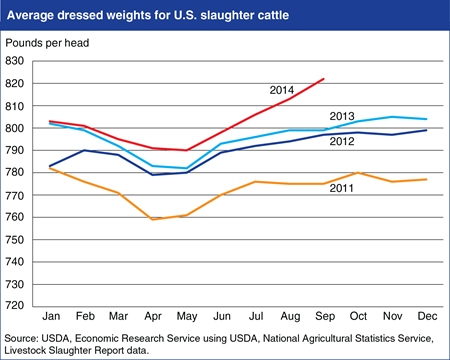U.S. Cattle Dressed Weights Reach Record Levels

The average weight of cattle slaughtered in the United States is increasing in 2014, as rising prices for cattle and beef, coupled with declining feed costs, have induced growers to feed cattle for longer periods.
The average dressed weight—the weight of the carcass minus feet, head, hide, and organs—of U.S. slaughtered cattle has been increasing in recent years, but rose sharply from 799 lbs/head to 822 lbs/head between September 2013 and September 2014.
U.S. cattle and beef prices have set a number of successive record highs since mid-2013 because of declining cattle inventories resulting from drought-degraded pasture and forage conditions during 2010-12. With improved weather, cow-calf operators appear to be rebuilding herds by retaining heifers for breeding, adding upward pressure to cattle prices.
Lower feed prices resulting from record U.S. corn and soybean crops are creating incentives to feed animals to higher weights. Also, as a direct result of placing fewer heifers in feed lots, there is a larger proportion of steers—which typically weigh more than heifers—in the slaughter mix, contributing to heavier average weights.
Find additional analysis in Livestock, Dairy, and Poultry Outlook: November 2014.
Source: USDA Economic Research Service







